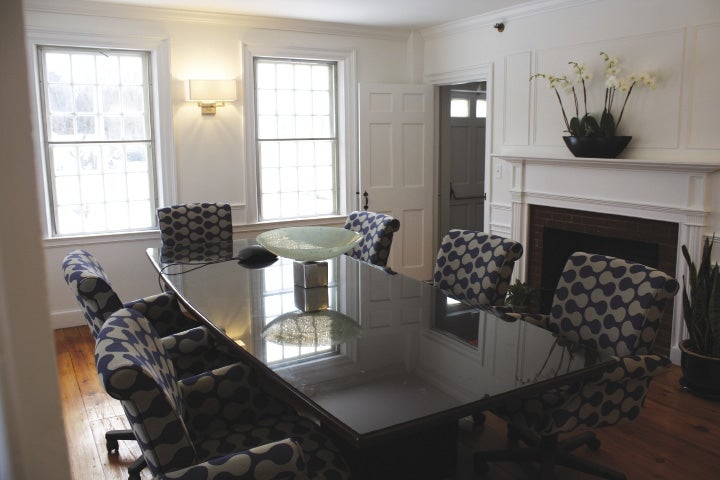The day a “For Sale” banner went up outside the former 1790 House on Route 9 eastbound in Westborough was a sad one for many area natives who viewed the historic restaurant as a landmark.
But Deborah Penta, owner of Penta Communications in Westborough, saw an opportunity. The entrepreneur had leased a modern office building up the road for years, and while it’s made a fine marketing and communications office, the 1790 House was a place Penta felt she could make her own.
The historic nature and architectural detail of the building were hard to resist.
Penta learned that Paul Revere and Gen. Marquis de Lafayette both had stopped at the site when it was Wesson Tavern, across the highway on what was known as Powder Hill, before the structure was relocated to its current spot.
Blending old and new
Penta, who has a personal interest in interior design and offers such services to clients, revamped the stately building to reflect the company brand and create a bright, modern work environment. But all historic elements that have earned the building a place on the National Register of Historic Places were maintained.
“It’s sort of like we’re blending the old and the new, and its all about the energy,” Penta said.
Penta’s highly visible example of transforming an historic building into a modern-day office is just one of several throughout MetroWest. While the process of bringing old properties up to present-day standards can be arduous, it’s one that many find worth it, even if it’s just for the charm.
Niche properties
Such was the case for Jim Levin, a Wellesley-based developer who revamped former mill buildings in Westborough and Holliston in the 1990s. The properties, on Water Street in Holliston and on Milk Street in Westborough, were renovated under the “adaptive reuse” philosophy, which means not all historic attributes were maintained through the process.
Levin sold both properties by 2011, and he said he made a 26-percent return on investment on the Westborough building, and a 50-percent return on the Holliston building. Both were nearly full at the time of sale, according to Levin, and continue to house some of the same tenants today — most of which are professional service firms.
“There is definitely a type of person who is attracted to that kind of space,” Levin said.
One those people is Tim Merry, owner of Merry Design Group, a branding and design firm that has set up shop at Levin’s Water Street project in Holliston since January 1996.
Merry described his decision to lease space on in the old mill building in simple terms.
“The reason we chose this space is because it’s like a tree house,” Merry said.
There are other reasons, of course. Merry said he felt the industrious nature of a mill building lent itself well to getting work accomplished in the modern era, too. And a resident of Sherborn, he enjoys being able to walk to work.
But it’s the space itself that makes coming to work so pleasant. It’s sun-splashed and airy, with original Georgia yellow pine floors and none of the drop ceilings found in modern offices, which Merry happens to loathe.
“It’s a beautiful place to live and work,” Merry said.
Winning workplaces
Indeed, companies are putting far greater emphasis in creating work environments that are conducive to productivity and creativity. Must-have elements include lots of light, greenery, and large open spaces conducive to collaboration, and Levin said those elements are easier to find in historic buildings, particularly those used in the industrial era.
While it may be cheaper to buy an older building, it doesn’t necessarily translate to lower rents for tenants, according to Levin. He was charging $17.48 per square foot at the Water Street mill building in Holliston before he sold his stake in the property in 2011; he said a comparable office building on Route 9 in Natick would have netted roughly the same price, plus more convenience for employees and clients. But tenants who are mindful of their work environments are willing to sacrifice some of the convenience.
“Where do you want to go to work every day? Because you don’t see clients every day,” Levin said.
Another route that developers sometimes take in Massachusetts is renovating historic buildings for modern use using historic tax credits to help defray some of the cost of construction. Levin did not pursue that option, he said, because historic tax credits did not outweigh the higher cost of renovating to preserve all original elements at his properties.
And preserving all historic elements can be more complicated. For example, if an old spiral staircase cannot be used because it is not up to code, it must be walled off but not torn down, Levin said. This can cut into layout plans and creates a problem of unused space. But Levin added that some developers do save money using historic tax credits; it just depends on the project.
Whether a developer preserves every historic detail of a property may not be as important as the impact a successful project has on the real estate landscape in the community. Westborough Town Planner Jim Robbins highlighted the importance of making defunct buildings habitable for the business tenants of today. He believes historic properties play a special role in the mix.
Robbins said news that the 1790 House closed and the building was for sale sent shockwaves through the community. But he’s relieved that it’s been redeveloped by Penta. The building has joined the ranks of other historic Westborough office buildings, including Levin’s Milk Street project, and others downtown, like the four-story building known as the American Block, and the Keating Building, now used as an art gallery.
“It’s good for property values,” Robbins said of the redevelopment. “Plus, it creates what planners call a ‘sense of place’.”

